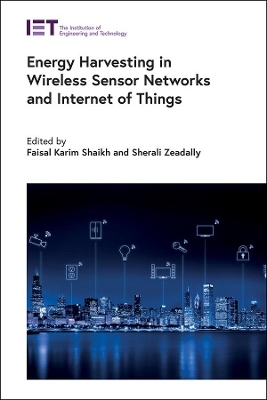
Energy Harvesting in Wireless Sensor Networks and Internet of Things
Institution of Engineering and Technology (Verlag)
978-1-78561-736-2 (ISBN)
The energy efficiency paradigm associated with Wireless Sensor Networks (WSNs) and the Internet of Things (IoT) is a major bottleneck for the development of related technologies. To overcome this limitation, the design and development of efficient and high-performance energy harvesting systems for WSN and IoT environments are being explored.
This edited book comprehensively covers energy harvesting sources and techniques that can be used for WSN and IoT systems. The authors cover energy harvesting, energy management and energy prediction models to maximize the energy harvested. They also identify major architecture advances to develop cost-effective, efficient, and reliable energy harvesting systems.
This is a useful reference for researchers, engineers, practitioners, designers, and R&D staff involved in the development of energy harvesting models, architectures and technologies for practical deployments in WSN and IoT environments. The book will be of interest to professionals involved in developing energy harvesting systems, industry practitioners, and manufacturers in IoT, sensing, and energy harvesting technologies. Finally, it will also be a useful reference for graduate, PhD and postdoctoral students following courses in WSNs, IoT and energy harvesting technologies.
Faisal Karim Shaikh is a professor in the Department of Telecommunication Engineering at the Mehran University of Engineering and Technology, Jamshoro, Pakistan. His research is focused on investigating energy-efficient communication protocols in wireless sensor networks (WSNs) for mobile, ubiquitous, and pervasive applications. He is interested in environmental monitoring, vehicular ad hoc networks, smart homes, telehealth (body area networks), and Internet of Things. He is a member of PEC, IEEE, and ACM. Sherali Zeadally is a professor in the College of Communication and Information at the University of Kentucky, USA. He is the editor-in-chief of the IET Wireless Sensor Systems Journal, a board member of the IET International Book Series on Sensors and he currently serves as an associate editor or editorial board member for over 30 international refereed journals. He is a fellow of the British Computer Society and a fellow of the IET.
Part I: Energy harvesting from ambient environments
Chapter 1: Thermal energy harvesting for wireless sensor networks
Chapter 2: Auxetic designs to improve ambient strain energy harvesting for WSN/IoT
Chapter 3: Energy harvesting from human body
Part II: RF energy harvesting
Chapter 4: Cognitive and energy harvesting-based D2D communication in wireless multimedia sensor networks underlying multi-tier cellular networks
Chapter 5: A systematic study on the metamaterial microstrip antenna design for self-powered wireless systems
Chapter 6: On the trade-off of RF energy harvesting and transmission intervals in cognitive IoT network using fuzzy logic
Part III: Emerging trends in energy harvesting
Chapter 7: UAV-assisted energy harvesting for WSNs/IoT networks
Chapter 8: A review on resonant beam communication with simultaneous wireless data transmission and energy harvesting techniques
Chapter 9: Simultaneous wireless information and power transfer in Internet of Things
Chapter 10: Energy-efficient computing for future IoT applications
Chapter 11: Intelligent MapReduce technique for energy harvesting through IoT devices
Part IV: Security and energy harvesting
Chapter 12: Hide-and-detect: forwarding misbehaviors, attacks, and countermeasures in energy harvesting-motivated networks
| Erscheinungsdatum | 02.02.2022 |
|---|---|
| Reihe/Serie | Control, Robotics and Sensors |
| Verlagsort | Stevenage |
| Sprache | englisch |
| Maße | 156 x 234 mm |
| Themenwelt | Technik ► Elektrotechnik / Energietechnik |
| Technik ► Nachrichtentechnik | |
| ISBN-10 | 1-78561-736-2 / 1785617362 |
| ISBN-13 | 978-1-78561-736-2 / 9781785617362 |
| Zustand | Neuware |
| Haben Sie eine Frage zum Produkt? |
aus dem Bereich


